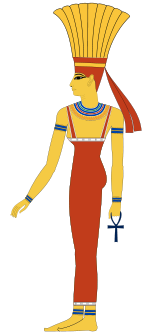- Anuket
-
Anuket in Hieroglyphen meistens 



ˁnq.toder 




oder mit Determinativ 




im Neuen Reich 





Transkription ˁnq.t griechisch ᾿Ανουκις (Anukis) Anuket Anuket (auch Anukis) war eine Wassergöttin aus dem Sudan, die auch in Ägypten verehrt wurde.
Inhaltsverzeichnis
Bedeutung
Anuket war die Göttin des ersten Katarakts (Nilquellen) und bildete dort zusammen mit Chnum und ihrer Schwester Satis die Göttertriade von Elephantine. Die Triade war für die Nilschwemme verantwortlich. Die Übersetzung ihres Namens bedeutet „umarmen“ und man glaubte, dass sie durch ihre Umarmung die Felder während der Überschwemmung fruchtbar machte. Sie trug somit dazu bei, die Ernährung des ägyptischen Volkes zu sichern. Manchmal findet sich auch eine Identifizierung mit Nephthys.[1]
Darstellung
Anuket wird meist als Frau dargestellt, die eine hohe Krone aus zusammen gebundenem Schilf und ein Zepter aus Papyrus trägt. Sie kann aber auch in Gestalt ihres heiligen Tieres, der Gazelle, auftreten.[2]
Kultorte
Außer als „Herrin von Elephantine“ wurde Anuket auch auf der Insel Sehel verehrt. Beide Orte waren Hauptkultorte und es sind mehrere Feste der Anuket bekannt. Nach Ausdehnung der ägyptischen Reichsgrenzen wurde sie auch an vielen Orten des eroberten Nubien verehrt.[3]
Siehe auch
Literatur
- Veronica Ions: Die großen Religionen der Welt – Götter, Mythen und Legenden, Verlag Buch und Welt 1988.
- Rolf Felde: Ägyptische Gottheiten, Wiesbaden 1995
- Hans Bonnet: Lexikon der ägyptischen Religionsgeschichte, Nikol-Verlag, ISBN 3-937872-08-6
Einzelnachweise
Wikimedia Foundation.


